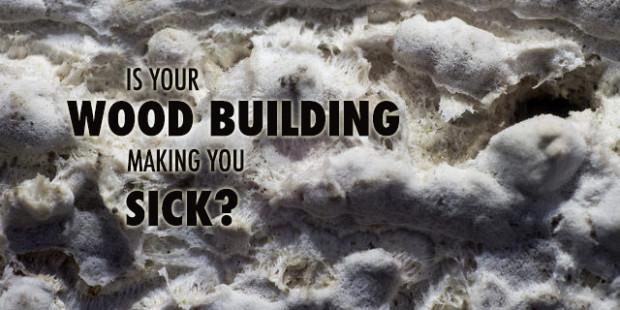Is Your Wood Building Making You Sick?

Before you engage in any purchase process, you like to gather all the facts. It’s no different when shopping for a building. If durability, flexibility and versatility are all important factors, then a custom residential metal building might be right for you. When you weigh all the pros and cons of a steel building versus a wood building, you likely look through a list, and make the best decision based on your budget and your needs. However, ‘look’ is the operative word in the last sentence. There is one element you can’t see – and we don’t want you to forget about it in the planning stages.
Air quality.
It’s invisible, and often forgotten. You or your family might be spending a great deal of time in your building. You’ll want to choose a inorganic building material that can combat moisture and reduce the likelihood you’ll encounter mold.
What is mold?
 Molds are a part of the fungi kingdom and is related to mushrooms, bracket fungi, and mildew. Fungi are known for extracting the nutrients they need from the organisms they grow on and they reproduce by shooting spores into the air. This is a detriment to air quality. These spores are launched with the intention of finding suitable conditions to grow. In order for mold to grow, it needs food, a suitable temperature, oxygen, and moisture. Fungi acts as a recycling process for nature and break down leaves, plants, wood, and other natural matter.
Molds are a part of the fungi kingdom and is related to mushrooms, bracket fungi, and mildew. Fungi are known for extracting the nutrients they need from the organisms they grow on and they reproduce by shooting spores into the air. This is a detriment to air quality. These spores are launched with the intention of finding suitable conditions to grow. In order for mold to grow, it needs food, a suitable temperature, oxygen, and moisture. Fungi acts as a recycling process for nature and break down leaves, plants, wood, and other natural matter.
Dangers of mold
First, understand mold is necessary in nature and serves an important purpose in our ecosystem. But it can be hazardous to your health. Mold survives by feeding off its host and can break down the strength of a structure. This is especially true if you own a wooden pole barn because wood contains sugars, starches, proteins, and other nutrients that can function as an initial food source for mold. Mold often can’t break down the bark of a living tree, but if the bark is stripped away or is fabricated into raw lumber, the protection weakens and could give way to a mold host. Mold can grow on steel as well, but since steel doesn’t have the natural nutrients that wood does, mold needs an outside food source to be present on steel to grow.
Once mold has found a place to grow, it will begin to fill the air with spores. It’s true the air we breathe everyday is filled with different spores and particles and usually we aren’t really affected. Not all spores are harmless either. According to the Environmental Protection Agency, “(m)olds have the potential to cause health problems. Molds produce allergens (substances that can cause allergic reactions), irritants, and in some cases, potentially toxic substances (mycotoxins).” Inhaling or touching mold or mold spores could cause allergic symptoms like sneezing, runny nose, red eyes, skin, rash, and hay fever symptoms. Even if you aren’t allergic to mold, your eyes, ears, skin, nose, throat, and lungs can become irritated over time due to constant exposure.
How to combat mold
 The number one way to fight mold is to prevent it right from the start. Steel framing is inorganic, so mold cannot feed from it. Steel framing also doesn’t hold moisture like a wood in a pole barn. When buying a building, you have choices. One of those big choices is building material. How long does the material last? Will it need to be replaced often, or not at all? Regardless of the building material you choose, keeping moisture out of your building is the most important thing you can do. Incorporating proper insulation in your custom residential metal building, regulating the temperature in your building, and installing proper ventilation will help you fight moisture. Should you find mold in your building, it’s vital to clean up the mold AND fix the moisture issue all at once.
The number one way to fight mold is to prevent it right from the start. Steel framing is inorganic, so mold cannot feed from it. Steel framing also doesn’t hold moisture like a wood in a pole barn. When buying a building, you have choices. One of those big choices is building material. How long does the material last? Will it need to be replaced often, or not at all? Regardless of the building material you choose, keeping moisture out of your building is the most important thing you can do. Incorporating proper insulation in your custom residential metal building, regulating the temperature in your building, and installing proper ventilation will help you fight moisture. Should you find mold in your building, it’s vital to clean up the mold AND fix the moisture issue all at once.
Mold is parasite that can hurt your building and, more importantly, you. Control the moisture, and you’ll be breathing easy for decades.
Photo courtesy: Mark Englebrecht, AdaptaLux
« The Competition is Building – Now It’s Your Turn
What is a General Contractor’s Secret Weapon? »
Popular Posts

Good advice is one of the most valuable things in this world. As a pastor, I’m sure you’ve given and taken your fair share over the years. Whether you’re preaching to the masses on Sunday or privately throughout the week, you advise people on all aspects of their life. Are you about to embark on… …

If you’re like me, you love doing two things on Sunday: Going to church, and watching football. I’m sure I’m just like many other Americans in that regard. So first, I’m going to ask you a football question – Does the name Steve Emtman ring a bell? You might hark back to his college football… …

